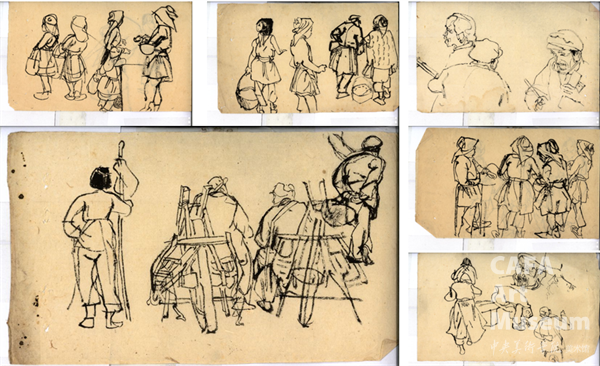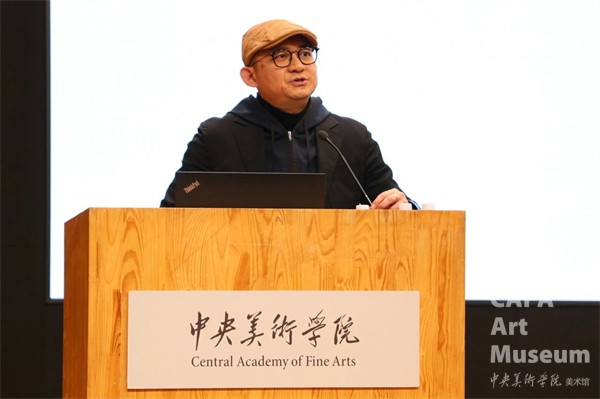

“图示新探:延安文艺座谈会讲话与现实主义艺术”系列学术讲座,由中央美术学院美术馆直属党支部主办,计划从一系列与中央美术学院美术馆收藏与展示的具体作品出发,围绕1942年毛泽东同志《在延安文艺座谈会上的讲话》对艺术创作与艺术研究产生的影响展开,譬如:文艺创作方向的转变、创作主题的变化、创作中对于人民群众形象的表现、历史史实与艺术表达的关系等等,以此进一步探讨《在延安文艺座谈会上的讲话》对中国现代美术创作中新图示的创造以及中国文艺理论研究等方面所产生的深远影响。
本系列学术讲座在第一期举办五讲,邀请殷双喜、杨灿伟、吴雪杉、于洋和李垚辰等美术史学者主讲,主题包括王式廓的《改造二流子》、延安版画与鲁艺木刻工作团、周令钊的《五四运动》、宋步云的《欢庆解放》和袁运生的《水乡的记忆》等。系列讲座的总召集为中央美术学院美术馆直属党支部书记韩文超。
2024年1月11日,由中央美术学院美术馆典藏部主任李垚辰开启第五讲,也是本次系列讲座第一期的最后一讲,讲座题目为“历史中的作品——袁运生《水乡的记忆》作品史研究”。此次讲座为中央美术学院美术馆直属党支部与中央美术学院艺术管理与教育学院党总支联合主办,由美术馆直属党支部书记韩文超担任讲座主持。

| 主讲人介绍 |

李垚辰
副研究员、博士,中央美术学院美术馆典藏部主任。近年从事美术馆典藏理论研究、近现代美术史研究,组织策划展览项目多次获得文化和旅游部奖励。
| 讲座内容 |

韩文超书记担任主持人
讲座伊始,韩文超书记作为主持人对此次讲座的主讲人和出席嘉宾进行介绍,结合自己的求学经历和工作经验对“图示新探”系列学术讲座的机缘与目的进行了简要说明,他谈到本系列讲座有着很长的时间脉络,可以追溯到毛泽东同志《在延安文艺座谈会上的讲话》发表80周年之际,讲话精神至今仍有持续性的影响,美术馆结合优秀馆藏作品对此做出回应,邀请学者进行探讨,并寻找馆藏当下的新时代意义是一个活化典藏的积极思路。他还谈到,美术馆也非常荣幸能够通过讲座为艺术管理与教育学院的青年教师和学生成长做出一些贡献,并表达了未来同艺术管理与教育学院之间开展深度合作的期待。

李垚辰老师在讲座现场
李垚辰老师首先对于参加讲座活动的两个支部的老师和观众表达了感谢,之后他以作品史的概念引入本次讲座的主题,指出要以看一个生命的态度看待一件作品的历史,本次讲座就将关注《水乡的记忆》这样一件作品的生命轨迹。李垚辰老师强调,我们认识的作品是艺术家塑造的,也是历史塑造的。作品经过流传成为观者眼中的作品,与作品本身诞生之初存在不同,其创作史和流传史共同构成了美术作品的完成历史,某种程度上,作品流传史对于美术作品的历史地位塑造作用更为突出。袁运生先生是20世纪非常重要的艺术家,其本科毕业作品《水乡的记忆》即是他艺术生涯的第一件壁画画稿,是他最早的成名作,也是带给他的人生许多历史挫折的一件作品。这件作品的创作与流传是一个非常有意思的个案,折射出许多美术史上的重要历史变迁,值得我们深入品味和思考。

袁运生《水乡的记忆》 布面油彩 243x245厘米 1962年 中央美术学院美术馆藏 此件作品曾于2021年4月在中央美术学院美术馆举办的“一段记忆的修复——袁运生《水乡的记忆》作品史研究”展览中展出。
1962年,袁运生先生毕业于中央美术学院,其毕业创作《水乡的记忆》在同代人中印象深刻,但仅有少量黑白图像流传。1979年江丰的文章《艺术创新贵在缘于生活》和1980年袁运生的文章《壁画之梦》中都认为此作品已经丢失。而且在这件作品也没有出现在本应收藏毕业创作的中央美术学院美术馆馆藏之中。《水乡的记忆》作品长期不知所踪,很少有人见过作品的原貌,仅存在人们的记忆之中,可谓是一件“失踪”的名作。

江丰 《艺术创新贵在缘于生活》 1979年 (《袁运生云南白描写生集》序言)
之后,李垚辰老师介绍了《水乡的记忆》的研究机缘和作品重现的历程。距作品创作一个甲子轮回之后,2020年底,袁运生先生委托家属提出捐赠《水乡的记忆》,同时经过与家属核实沟通,发现家中还一直珍藏有大批量的创作草图、笔记,这为进行深入的作品个案研究提供了历史机会。自始,李垚辰就开始了围绕作品自孕育到创作直至失踪、修复、捐赠的全过程研究,通过时间的线索,挖掘作品创作的故事,社会对于作品评价的变化和传奇经历,作品如何被重新发现、修复,又有何种机缘捐赠学校这几方面恢复作品破碎的记忆,认识一段特殊时期美术史的变迁。
进而,李垚辰老师开始针对《水乡的记忆》创作史和流传史两个方面,进行重点讲述。对《水乡的记忆》的创作史,从理想、动力、酝酿、准备、实施、品评六个维度展开叙述,分析文献和画稿中的艺术家思考,依据艺术创作的规律和过程寻找、拼合创作过程的历史链条,生动还原其艺术创作的全过程。
李垚辰认为袁运生的艺术志向的确立是在中央美术学院学习期间。1955-1961年这段时期,董希文先生、西盖罗斯以及江丰先生这三个重要人物,从不同方面影响了袁运生的艺术思想与人格个性,对于他的人生成长起到重要的节点性作用,也为《水乡的记忆》的创作提供了明确的历史观与原始冲动。

1961年1月,袁运生在双桥农场为江丰作肖像速写,江丰一直将此画挂在家中多年
袁运生《水乡的记忆》创作的成功,与他特殊的历史遭遇有很大关系,他的人生历程并非一帆风顺,大学期间他从“天才学生”到被“错划右派”,作为典型在《美术》杂志受到全国性批判,并到双桥农场进行劳动改造,这一系列从思想上到生活上的打击,对于年轻的袁运生是非常刻苦铭心的,他充满激情的内心被压制了多年,他像一个弹簧一样被历史重重的压了下来。1961年下半年学校允许他重新回校参加毕业创作,可以说对于袁运生来说是难得的机会。他已经失去了两年的学习时间,他的同学都已经毕业,他对于这次毕业创作有着非常大的抱负,希望能够一展身手,并为自己正名,所以他有了非常大的“动力”投入到在创作中。
在作品的酝酿阶段,李垚辰从两个方面进行了分析,一方面从艺术本体语言上,分析袁运生为了毕业创作所做的技术准备和他的艺术来源,另一方面,从袁运生的情感和时代背景上,分析袁运生对于毕业创作最终题材的选择。袁运生的的创作技术来源于敦煌和陈老莲,导师董希文一直称赞的敦煌壁画和中国传统的线描,一直是袁运生脑中萦绕的概念,他希望通过他的毕业创作将中国传统的优秀文化遗产融入进来,探索中国自己的民族风格。为此,他专程去上海观看敦煌的展览,并在家中认真临摹陈老莲的博古叶子。这两个艺术语言的来源在他之后的创作中有着明显的体现。袁运生的毕业创作活动正好是是寒假期间,也是中国传统的春节,他希望将毕业创作的题材落实到他深爱的故乡——江南的水乡中。而1961年兴起的短暂的“三自一包”政策,使得水乡的农村经济有了一定的活跃,人民生活有所改善,心情和社会氛围都宽松了很多,这一特殊背景蕴含了独特的时代机遇。也是在这样的时刻,他在1962年春节期间回到家乡,正好看到春节期间熙熙攘攘的人群,脸上洋溢生活喜悦的人们让他回想起自己的童年,倍感温馨,这种发自内心的喜悦与他此时从农场返回学校的喜悦心情十分的一致,水乡朝气的氛围正是他所追求的时代氛围,故而迸发了灵感的闪光点。

1962年春节前后,袁运生在家中临摹陈老莲的博古叶子,用白描临摹了一套48张。

1962年春节后,袁运生在甪直保圣寺写生十八尊罗汉塑像
产生灵感后,袁运生先生进入了他的作品准备阶段。艺术家的创作准备是一个复杂而又不易梳理的过程。李垚辰通过对于《水乡的记忆》的笔记和采风速写的认真品读和仔细辨识,梳理出来袁运生在准备素材阶段的大致脉络,袁运生在准备阶段进行了两次采风与勾稿的工作,一次是在春节期间,在相关手稿中可以看到画中人物身上裹着的棉衣,以及萧瑟的气象,一次是在董希文先生肯定了创作选题之后,四月份,袁运生又一次回到家乡,搜集更多的创作素材。李垚辰老师在现场展示了丰富的画稿图像,指出画稿对于人物、场景的状态都有着非常敏锐的捕捉,可以看出艺术家本人不断在进行形象的提炼与归纳。幸运的是,袁运生还保存有一些采风时的笔记记录,可以看到他采风的路线和寻找的素材。

1962年2月袁运生第一次回到家乡采风的部分速写

《水乡的记忆》创作素材之 124 袁运生 12×19.8cm 1962 纸本墨笔 2021年艺术家捐赠中央美术学院美术馆

1962年4月袁运生第二次回到家乡采风的笔记

1962年4月袁运生第二次回到家乡采风的水彩写生
《水乡的记忆》定稿创作的时间并不长,大约仅有一个多月,面对6平米多的画面,袁运生把自己所在了一个教室中安心创作。并且,李垚辰梳理了艺术家周密的创作计划,从残破的创作手记中可以看出,他给自己制定了严格的工作时间安排和创作原则,要求自己“必须是感情地去画”,对于构图、色彩、绘制步骤都有着非常明确的要求和计划,并且对于画面中的十几组主要人物都有着认真的形象推敲,在目前可以看到的推敲稿当中,画面重要的部分都有改动,展现了超越同龄人的完整自主的创作思考。李垚辰老师特别提到,在2023年筹备“纵浪大化——袁运生与壁画梦”展览时,发现了一张长构图画稿,得知原计划是创作7米横长的构图,但由于毕业创作的时间紧迫,在老师董希文先生的劝说下改为了现在所见的正方形构图。《水乡的记忆》由三座桥和两条河架起画面主干,远房、远帆、云彩、住宅、集市,以十三组场景描绘了春节的欢快气氛,画面上大小人物有一百三十余位,李垚辰老师认为,如此密集的内容分布在毕业创作中是十分难得的。画面上出现的房顶上的花、小动物,以及摊位上售卖的玩具、花灯都描绘得非常具体,展现了艺术家对生活的深入与熟稔。

袁运生《水乡的记忆》创作笔记中写道“必须是感情地去画”

《水乡的记忆》各局部创作推敲稿与作品的位置关系对比

袁运生创作《水乡的记忆》时关于作品构图中动静安排的创作笔记
接下来,李垚辰老师以赞扬与争议、作品的失踪、修复、捐赠及展示五个方面进入到流传史的分析中。

1962年 第三画室师生在中山公园举行毕业总结时留影(左起:董希文、许幸之、艾民有、袁运生、王路、颜铁铮、费正)
1962年,作品一经出世,虽然得到了董希文先生满分“5”分的赞赏,但美院另一些教师认为作品不能及格,只能得到“2”分,在集体讨论之后,由于董希文先生的辩护和坚持,折中给到“4+”的分数,这个分数在当时的同班同学心中很是不解,艾民有就曾经提到这么好的作品为什么仅仅给了一个“4+”。之后,作品参加了北京市美协举办的“新芽美展”,这次展览当中推出了当年的很多优秀毕业创作,有很多成为了美术史上的经典。而《水乡的记忆》在展出过程中,也在社会上引起强烈反响和极大争议。有观点认为作品“吸取了许多民族、民间的营养,在油画民族化上迈开了一大步”,此外,也有观点认为作品展现的人物形象陈旧、丑陋,没有正确表现劳动人民,实际上,作品只是相对忠实于当时的场景进行真实地捕捉,没有加以美化。1963年《美术》第三期,柳闻莺的文章 《要正确表现劳动人民》 中重点批判了袁运生的《水乡的记忆》和上海画家杨文秀的作品,使得《水乡的记忆》在官方专业媒体上被批判,并被定为没有正确表现劳动人民的典型。文章批评得非常犀利,认为“气象为什么如此陈旧。人物又近乎丑陋,这种不健康的情调还出现在今天的艺术创作里,是多么不协调。作者为什么要这样画呢,有人说,这也许是在探索"新的表现方法",探索"独特的形式风格"……不论作者所描绘的是旧时的记忆忆,还是新生活的印象,总不应该丑化劳动人民的形象,把他们画成体态畸形和有暗淡情绪的样子。”一时间,《水乡的记忆》成为全国皆知的丑化劳动人民形象的作品,被打入冷宫,成为了被批判的典型。这也为《水乡的记忆》的最终失踪埋下了伏笔。

柳闻莺 《要正确表现劳动人民》 刊于1963年《美术》第三期第30页
《水乡的记忆》有着几十年的失踪经历。最早的失踪经历是源自袁运生的好友张朗朗对于作品的保护。1964年,为避免作品因批判而遭到损毁,在校上学的张郎郎将作品裁下偷走,偷偷放在自己家中。后来被发现后,被告发,不得不归还了学校。但是因为各种历史运动的缘故,归还至学校的《水乡的记忆》却再也没有人见过,作品多年不知所踪,进入到了漫长的“失踪”历程中。而在失踪期间,作品却依然作为那个时代优秀的教学成果,被艾中信、詹建俊、侯一民、靳尚谊、吕胜中等艺术家和学者不断地提及,萦绕在人们的心中。
2017年,在袁运生先生家中翻找出破损不堪的《水乡的记忆》原作,家中决定委托修复师尤拉老师对《水乡的记忆》进行修复。作品历经辗转破损程度较高,出现撕裂、缺损、折痕和脱色现象,这时的作品犹如一个已经奄奄一息的生命,如果不加以合适的保护,就会彻底消失。修复者的参与,为作品换发艺术生命提供了第二次机会,也使作品拥有了新的生命。经过缝合、加固、补底、补色、光油保护等修复步骤,历时三年,《水乡的记忆》重新焕发光彩。


《水乡的记忆》修复前后对比
2020年,美术馆正式接受《水乡的记忆》原作、画稿及相关笔记的捐赠,共计167件,并于次年申报国家美术作品收藏和捐赠项目,筹备捐赠作品展览。今天,关于这件传奇作品的作品史仍在延续当中。2023年,中央美术学院美术馆主办的“纵浪大化——袁运生与壁画梦”再次展出了这件作品。

2020年,美术馆正式接受《水乡的记忆》原作、画稿及相关笔记的捐赠

2020年4月23日至5月1日,关于《水乡的记忆》传奇经历的展览”一段记忆的修复——袁运生《水乡的记忆》作品史研究”展览在中央美术学院4层展厅展出

讲座现场
讲座最后,李垚辰老师总结了由《水乡的记忆》研究产生的三点研究思考:第一,不同的时代,对于一个作品形象的看法会产生不同,历史在塑造着我们所认识的艺术作品,艺术作品会随着历史的发展而发生沉浮,在六十年代《水乡的记忆》是被批判的代表,而今天站在艺术家整体创作历程来看,这是一件里程碑式的成名作,我们如何透过历史的表象,需找到作品的历史真相,看到真正生命力所在才是研究和认识艺术作品的重要方法;第二,没有艺术家持之以恒的创作,作品“失踪”以后更可能面临被历史淹没的命运,正是因为袁运生先生自身的艺术成就的不断突破,《水乡的记忆》作品才会被学界所“牵挂”,再次回到大众视野之中;第三,艺术作品的流传离不开修复维护,如果作品损毁、无法被修复,再多的关注也无法推动作品的传播。

杨杰书记作总结致辞
讲座结束后,中央美术学院艺术管理与教育学院党总支书记杨杰作为讲座的共同主办单位进行总结。杨杰书记首先表达了对主讲人李垚辰的感谢,他认为馆藏个案研究是非常好的典范,对未来的教学研究都有着启发作用,百年央美是丰富历史的代表,未来教学要挖掘央美自身的历史传统资源,以新的角度细致入微地将作品和问题探讨清楚,这也是校训“尽精微,致广大”的最好印证。其次,他再次对主办方表示感谢,并表达了对未来继续合作的期待。
此外,他认为此次讲座活动能够引领示范相关组织活动的开展,不仅要加强思想理论的学习,更要在专业和本职方面精进学习,切实贯彻上级要求,以学促干,学以致用。最后,他表示虽然此次讲座是“图示新探”系列的最后一讲,但也是承前启后的一讲,新的一年艺术管理与教育学院也会以此作为示范借鉴。这个系列讲座对教师和学生自身专业、工作,乃至整个学校的发展都有着现实意义。

参与讲座嘉宾合影
文字整理 / 李佳蒙

“图示新探:延安文艺座谈会讲话与现实主义艺术”系列学术讲座
主办:中央美术学院美术馆直属党支部
召集:韩文超
执行:刘希言、李垚辰、张倩、胡晓岚、李捷、闵志伊
